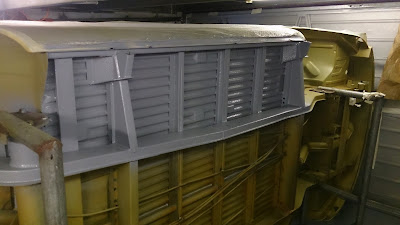While my van was sitting in a damp garage waiting to be saved it's front and back bumpers were hanging under the garages leaking gutter collecting the rain water and directing it onto the garage floor, destroying my stuff.
So as a result, and maybe because they are 45 years old my bumper were very rusty mostly on the inside.
Rather than spend days with the grinder and wire wheel I decided to get the bumpers sand blasted. Because they were to big for the blast booth they could not do a great job,(if they had let me do it I could have done a better job) I now had to get out my wire wheel.
A bit bemused I figured I could poor some oxalic acid solution in to it and leave it for 24 hours.
Forgetting about the bumper because I didn't get into the garage for 7 day, I was left with a rusty water mark around the edge of a pool of sludge and crystal saturated oxalic acid solution
Once the solution was cleaned out and filtered to use again later I was left with a yellow coated bumper, once cleaned up the pitted rust was gone, and the tide mark of rust from the evaporated water cleaned up quick with the wire wheel.
To get under the mount brackets I made a bath with a dam of plastic bottle sides and plasticine
Although the plasticine did start to crumble a little the dams held for 24hr
Because I neglected the fresh sandblasted bumpers my greasy hand had left marks on the out side where Id handled it.
I did not have any gel rust treatment so to stop the rust blast liquid I did running off the bumper I laid a piece of tissue paper over the area and dabbed through the paper to treat the areas I needed to.
A day spent filling flatting, filling flatting and filler primer eer ring, and I had a prepped front bumper.
I didn't realise this till quite late on, I had a dimond cut rear bumper (the shape on the left lower bumper end) rather than (what I think is the right year for a 1964) a slash cut one.
After a bit of deliberating and looking for a second hand rear bumper I decided to spend the money on a repro one. The quality is not to bad, its rust free and feels maybe a gauge thinner.
The repro bumper had a small cut out on the lower side, not sure if this is for clearance of the exhaust tail pipe support bracket or not.
I was not sure if should be there on a 64 bus, so I decided to weld it up anyway.
It turned out a very neat welding job, I must be getting better at welding or thicker metal is easier to weld.
The manufacturing marks and there company logo stamp needed a bit of filler.
Then a coat of primer ready for another flatting before paint.












































